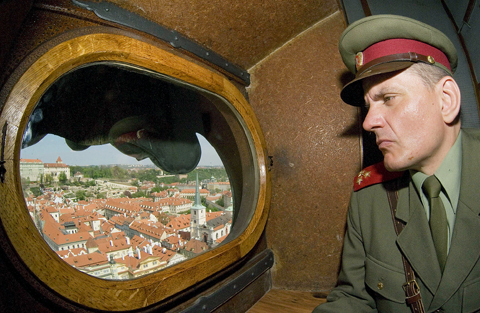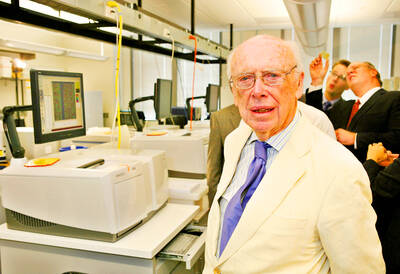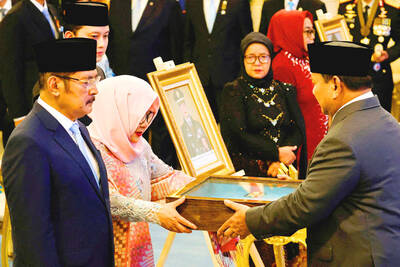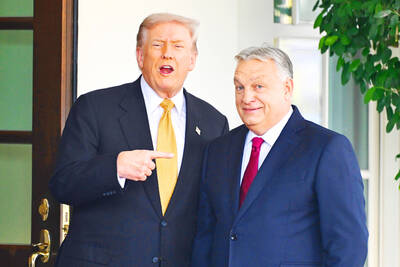High up in a Prague belfry a radio transmitter, faded clippings of the 1967 European Cup and communist propaganda are frozen in time in a tiny spy lookout used by the old regime’s dreaded StB secret police.
With the fall of communism in 1989, the plywood cubicle was sealed up and forgotten — until it was reopened last month, this time for the public, offering breathtaking rooftop views and a glimpse back at a sinister time.
The four windows of the sparsely furnished office look down at some half dozen “imperialist” embassies, as well as medieval landmarks like Prague Castle and Charles Bridge.

PHOTO: AFP
“The StB wasn’t called the party’s eyes and ears for nothing,” said Ladislav Bukovszky, head of the Czech Security Services Archive. “It monitored Czechs and Slovaks as well as foreigners, paying special attention to the employees and visitors to embassies.”
Reached by a hefty climb up 301 stairs, the lookout was built on beams in a bell tower of the old baroque church of St Nicholas. Aging bills in now-open secret police archives show StB agents pretended to be fire department officials when they rented the space from the parish.
From the lookout, agents had a perfect view of the British embassy and of parts of the French, German, Italian, Japanese and US facilities.
“As a rule, the StB tried to monitor everyone who walked into a capitalist embassy,” said Jiri Reichl of the Institute for the Study of Totalitarian Regimes in Prague.
The St Nicholas lookout was one of about 80 “strongpoints,” as they were called, set up in Prague’s towers, attics or cellars so secret police could snoop on “enemies” of communism.
Like the others it was abandoned early in 1990, months after the regime was toppled. It’s the only one that has been reopened for tourists after a private firm happened upon the site.
“When we found out the unique lookout was there, we immediately decided to invest in it and open it to the public,” Zuzana Fryaufova of the ABL FM Services company said.
“The lookout itself was very well-preserved, including beer labels, photographs on the walls and a makeshift toilet,” ABL’s executive director Matej Barta said.
With help from an old picture found in secret police files, other details were added to recreate the ambiance. In all, the firm sank almost 1.5 million koruna (US$72,000) in a four-month restoration project and now charges a 100 koruna entrance fee.
“We made it look exactly the same,” Fryaufova said. “It’s an absolutely authentic reproduction.”
They found targets by using binoculars.
“It was above all retired secret police officials who worked in this system of strongpoints,” said Reichl, and the lookout indeed shows a man’s world.
Its walls are plastered with articles on the Dukla Prague, the once-famous army football team, at the 1967 European Cup — its win over Ajax Amsterdam and its draw with eventual champions Glasgow Celtic.
An alluring young woman with a tennis racket peers out from another poster advertising a “summer beauty show” at a department store, and a urinal offered comfort.
Newspapers from the 1980s — mostly the communist party’s mouthpiece Rude Pravo — clutter a tiny table next to a transmitter. On the door hangs a 1977 calendar with an agent’s reminder, in red ink, to get a vaccination.
Official records say monitoring began in the lookout in 1960, though Fryaufova said signs indicate it started in 1952 and continued until shortly after the 1989 revolution.
Such towers played a key role in secret police surveillance. One of the more infamous was opposite the house of Vaclav Havel, a leading dissident during communism who became Czechoslovakia’s first post-communist president, then president of the Czech Republic from 1993 to 2002 after Czechoslovakia split.
“The StB took pictures of all people who went to Havel’s house,” Reichl said.
At St Nicholas, the radio transmitter was linked to police working nearby so the belfry team could guide officers tailing a “suspect” if they lost the target.
“The men in the tower found the target with binoculars and let the guys on the ground know,” Reichl said.
They could also call off an agent when a target suspected he was being tailed.
“If you looked over your shoulder, you didn’t see anyone, but you were still being watched from the tower,” Reichl said.
While revamping St Nicholas lookout, the ABL firm also reinstalled two huge 18th-century bells directly above the lookout which had been removed after the communists came to power in 1948. Their clanging now gives visitors a start, every 15 minutes.
“We had to clean half a meter of pigeon droppings,” said Fryaufova, pointing at the bells through a window in the cubicle’s ceiling. “But St Nicholas is finally ringing again.”

James Watson — the Nobel laureate co-credited with the pivotal discovery of DNA’s double-helix structure, but whose career was later tainted by his repeated racist remarks — has died, his former lab said on Friday. He was 97. The eminent biologist died on Thursday in hospice care on Long Island in New York, announced the Cold Spring Harbor Laboratory, where he was based for much of his career. Watson became among the 20th century’s most storied scientists for his 1953 breakthrough discovery of the double helix with researcher partner Francis Crick. Along with Crick and Maurice Wilkins, he shared the

OUTRAGE: The former strongman was accused of corruption and responsibility for the killings of hundreds of thousands of political opponents during his time in office Indonesia yesterday awarded the title of national hero to late president Suharto, provoking outrage from rights groups who said the move was an attempt to whitewash decades of human rights abuses and corruption that took place during his 32 years in power. Suharto was a US ally during the Cold War who presided over decades of authoritarian rule, during which up to 1 million political opponents were killed, until he was toppled by protests in 1998. He was one of 10 people recognized by Indonesian President Prabowo Subianto in a televised ceremony held at the presidential palace in Jakarta to mark National

US President Donald Trump handed Hungarian Prime Minister Viktor Orban a one-year exemption from sanctions for buying Russian oil and gas after the close right-wing allies held a chummy White House meeting on Friday. Trump slapped sanctions on Moscow’s two largest oil companies last month after losing patience with Russian President Vladimir Putin over his refusal to end the nearly four-year-old invasion of Ukraine. However, while Trump has pushed other European countries to stop buying oil that he says funds Moscow’s war machine, Orban used his first trip to the White House since Trump’s return to power to push for

LANDMARK: After first meeting Trump in Riyadh in May, al-Sharaa’s visit to the White House today would be the first by a Syrian leader since the country’s independence Syrian President Ahmed al-Sharaa arrived in the US on Saturday for a landmark official visit, his country’s state news agency SANA reported, a day after Washington removed him from a terrorism blacklist. Sharaa, whose rebel forces ousted long-time former Syrian president Bashar al-Assad late last year, is due to meet US President Donald Trump at the White House today. It is the first such visit by a Syrian president since the country’s independence in 1946, according to analysts. The interim leader met Trump for the first time in Riyadh during the US president’s regional tour in May. US envoy to Syria Tom Barrack earlier